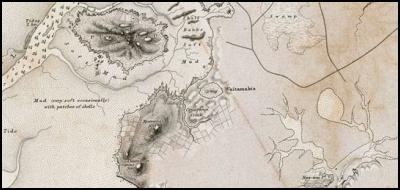Report fails to identify significant archaeological finds
Fletcher report fails to identify significant archaeological finds at Ihumātao
A review by senior Auckland archaeologist Ian Lawlor challenges the draft archaeological work, commissioned by Fletcher, for its application to Heritage New Zealand Pouhere Taonga for an authority to modify and destroy archaeological sites located within the proposed SHA 62 development at Ihumātao.
Lawlor states that there is physical and documentary evidence to indicate that major stone wall structures, on land designated as SHA62 at Ihumātao, were created by local Māori prior to European settlement of the area.
The Fletcher report however seems to assume that the large standing walls on the south section of the property were of European construction.
The archaeological review follows the recent discovery of a surface midden (now recorded as part of the development area with the NZ Archaeological Associates site record file), which the Fletcher survey also failed to find.
These discoveries reinforce the special values of the land. As Pania Newton, spokesperson for the campaign to protect Ihumātao says: "This confirms what we have always known, that is that this whenua is very significant”.
Other similar features originally prompted the then Manukau City Council decision in 2006 to have the land in question incorporated into the Otuataua Stonefields Historic Reserve. But this decision was ignored when the Auckland Super-City was created.
Lawlor suggests, on the basis of their location, structure and orientation, that the stone walls “most likely date between the period 1846 to 1863, and they represent historic remnants of historic Maori farming activities”.
This would mean that the walls were built well before the land was unjustly confiscated from local Māori in the 1860s. The walls may be the last remnant of the kilometres of stone walls depicted in the area on Captain Byron Drury’s 1853 Manukau Harbour Maritime Survey map.

The omission
of these archaeological taonga calls into question not only
the integrity of the Fletcher report, but also the resource
consent approval obtained by Fletcher and the viability of
the proposed SHA.
Newton adds: "I can't believe that the 'independent' commissioners granted consent before the land could be properly investigated by archaeologists. From what I remember, the archaeology was their biggest concern, yet they still consented to it. To be honest, I'm losing faith in the system and the processes after the surfacing of all these Fletcher inconsistencies.”
The walls and other features must be preserved so that future generations can see, enjoy and learn from early evidence that helps to tell the story of the beginnings of our country.
The structures are large (hundreds of metres), damaged in places by subsequent settler structures such as near Ihumātao Quarry Rd, but still in remarkably good condition.
The walls that enclose what were probably large garden areas are highly significant. They demonstrate extensive Maori land use beyond the Otuataua Stonefield Historic Reserve, on the prime horticultural volcanic rock-free tuff soils of Ihumātao.
Archaeologist Dave Veart says: “This is exciting information. We know the people living at Ihumātao at this time were growing fruit and vegetables and milling flour that they sold to the growing settlements of Auckland and Sydney. These walls are a very rare, possibly unique, survivor from this period.”
“It means that the land proposed for the Fletcher housing development tells the story of a world where Maori entrepreneurs fed the new European settlers, a world destroyed by the land confiscations of the 1860s,” he adds.
In addition to these surface structures showing clear evidence of early Māori use of the now SHA 62 designated site, Lawlor’s review identifies other important structures that show early settlers also working the land.
Significant historic European farming stonework and, other structures and plants, were also ignored in the Fletcher report and should be protected. There are potential sub-surface Māori remains and artefacts, particularly where the stone walls have protected garden spaces from later ploughing.
SOUL (Save Our Unique Landscape) Campaign is seeking to stop the Special Housing Area development because of the important historical and cultural values of this land and want it to become part of the Otuataua Stonefields Historic Reserve as was originally promised by Manukau Council.
According to SOUL the land now known as SHA62 and the Otuataua Historic Stonefields Reserve are part of one inseparable landscape.
ends


 Gordon Campbell: On Peter Dutton’s Fading Election Prospects.
Gordon Campbell: On Peter Dutton’s Fading Election Prospects. NZCTU: Transformative Policy Vision For Aotearoa
NZCTU: Transformative Policy Vision For Aotearoa Sensible Sentencing Trust: Greens Claim Intellectual Property Rights And Demand Changes To “Defund The Police” Billboards
Sensible Sentencing Trust: Greens Claim Intellectual Property Rights And Demand Changes To “Defund The Police” Billboards Te Pūtahitanga o Te Waipounamu: New Research Finds Dumped South Island Whānau Ora Agency An Exemplar Of Effective, Community-Led Public Service Delivery
Te Pūtahitanga o Te Waipounamu: New Research Finds Dumped South Island Whānau Ora Agency An Exemplar Of Effective, Community-Led Public Service Delivery NZ Nurses Organisation: Nurses’ Union Backs Call To Scrap Anti-Treaty Bill
NZ Nurses Organisation: Nurses’ Union Backs Call To Scrap Anti-Treaty Bill New Zealand Defence Force: Final Court Of Inquiry Into HMNZS Manawanui Grounding And Sinking In Samoa Released
New Zealand Defence Force: Final Court Of Inquiry Into HMNZS Manawanui Grounding And Sinking In Samoa Released Organics Aotearoa NZ: Gene Tech Bill - A High-Stakes Gamble That Risks Farmers’ Livelihoods, Trade, And NZ’s Global Reputation
Organics Aotearoa NZ: Gene Tech Bill - A High-Stakes Gamble That Risks Farmers’ Livelihoods, Trade, And NZ’s Global Reputation


